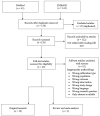How 25(OH)D Levels during Pregnancy Affect Prevalence of Autism in Children: Systematic Review
- PMID: 32752078
- PMCID: PMC7468823
- DOI: 10.3390/nu12082311
How 25(OH)D Levels during Pregnancy Affect Prevalence of Autism in Children: Systematic Review
Abstract
Autism spectrum disorder (ASD) is a group of dysfunctions in social interaction, communication, and behaviors. The etiology of ASD is not yet fully understood; however, it consists of the interaction between genetics and the environment. An increasing amount of evidence points to the possibility that gestational and early-childhood vitamin D deficiency may be involved in the etiology of some cases of ASD. Herein, we systematically review the literature for studies on vitamin D status during pregnancy and ASD outcomes. Forty-three studies in the PubMed and 124 studies in EMBASE databases were initially found. After screening, 26 were identified as candidate studies for inclusion. Finally, 14 articles met the inclusion criteria, which originated from nine countries. The studies included 10 original research studies and four review studies conducted between 2012 and 2020. The strength of evidence that vitamin D levels during pregnancy increase the risk of developing autism is very low. This is because the evidence relies exclusively on observational studies that did not equally consider all important confounders and that assessed the indirect relationship between vitamin D as a surrogate for sunlight exposure and autism risk. The findings of this systematic review are consistent with the hypothesis that low vitamin D levels might contribute to the development of autism. However, we must also recognize the possible confusion bias and therefore experimental studies with very large sample sizes, given incidence of autism, that allow us to detect blood levels in pregnant women would be helpful to clarify this point.
Keywords: dynamic programming; hedging; post-decision state variable; risk management; transaction costs.
Conflict of interest statement
The authors declare no conflict of interest.
Similar articles
-
Modifiable Nutritional Biomarkers in Autism Spectrum Disorder: A Systematic Review and Meta-Analysis of Vitamin D, B12, and Homocysteine Exposure Spanning Prenatal Development Through Late Adolescence.Int J Mol Sci. 2025 May 6;26(9):4410. doi: 10.3390/ijms26094410. Int J Mol Sci. 2025. PMID: 40362647 Free PMC article. Review.
-
Vitamin D and autism, what's new?Rev Endocr Metab Disord. 2017 Jun;18(2):183-193. doi: 10.1007/s11154-017-9409-0. Rev Endocr Metab Disord. 2017. PMID: 28217829 Review.
-
Bench to bedside review: Possible role of vitamin D in autism spectrum disorder.Psychiatry Res. 2018 Feb;260:360-365. doi: 10.1016/j.psychres.2017.12.005. Epub 2017 Dec 6. Psychiatry Res. 2018. PMID: 29241119 Review.
-
Maternal vitamin D levels and the autism phenotype among offspring.J Autism Dev Disord. 2013 Jul;43(7):1495-504. doi: 10.1007/s10803-012-1676-8. J Autism Dev Disord. 2013. PMID: 23070790
-
Newborn vitamin D levels in relation to autism spectrum disorders and intellectual disability: A case-control study in california.Autism Res. 2019 Jun;12(6):989-998. doi: 10.1002/aur.2092. Epub 2019 Mar 18. Autism Res. 2019. PMID: 30883046 Free PMC article.
Cited by
-
Molecular pathways in placental-fetal development and disruption.Mol Cell Endocrinol. 2024 Feb 1;581:112075. doi: 10.1016/j.mce.2023.112075. Epub 2023 Oct 16. Mol Cell Endocrinol. 2024. PMID: 37852527 Free PMC article. Review.
-
Maternal vitamin D during pregnancy and offspring autism and autism-associated traits: a prospective cohort study.Mol Autism. 2022 Nov 12;13(1):44. doi: 10.1186/s13229-022-00523-4. Mol Autism. 2022. PMID: 36371219 Free PMC article.
-
Steroid hormone pathways, vitamin D and autism: a systematic review.J Neural Transm (Vienna). 2023 Mar;130(3):207-241. doi: 10.1007/s00702-022-02582-6. Epub 2023 Feb 8. J Neural Transm (Vienna). 2023. PMID: 36752873
-
GC1f Vitamin D Binding Protein Isoform as a Marker of Severity in Autism Spectrum Disorders.Nutrients. 2022 Dec 3;14(23):5153. doi: 10.3390/nu14235153. Nutrients. 2022. PMID: 36501185 Free PMC article.
-
Environmental Influences on Individuals with Autistic Spectrum Disorders with Special Emphasis on Seasonality: An Overview.Children (Basel). 2023 Nov 25;10(12):1851. doi: 10.3390/children10121851. Children (Basel). 2023. PMID: 38136053 Free PMC article. Review.
References
-
- American Psychiatric Association . Diagnostic and Statistical Manual of Mental Disorders. DSM-V; Washington, DC, USA: 2013.
-
- Zablotsky B., Black L.I., Maenner M.J., Schieve L.A., Blumberg S.J. Estimated Prevalence of Autism and Other Developmental Disabilities Following Questionnaire Changes in the 2014 National Health Interview Survey. Natl. Health. Stat. Rep. 2015;87:1–20. - PubMed
-
- Centers for Disease Control and Prevention Prevalence of Autism Spectrum Disorders-Autism and Developmental Disabilities Monitoring Network, United State, 2006. MMWR Surveill. Summ. 2009;58:1–20. - PubMed
Publication types
MeSH terms
Substances
LinkOut - more resources
Full Text Sources
Medical
Miscellaneous


